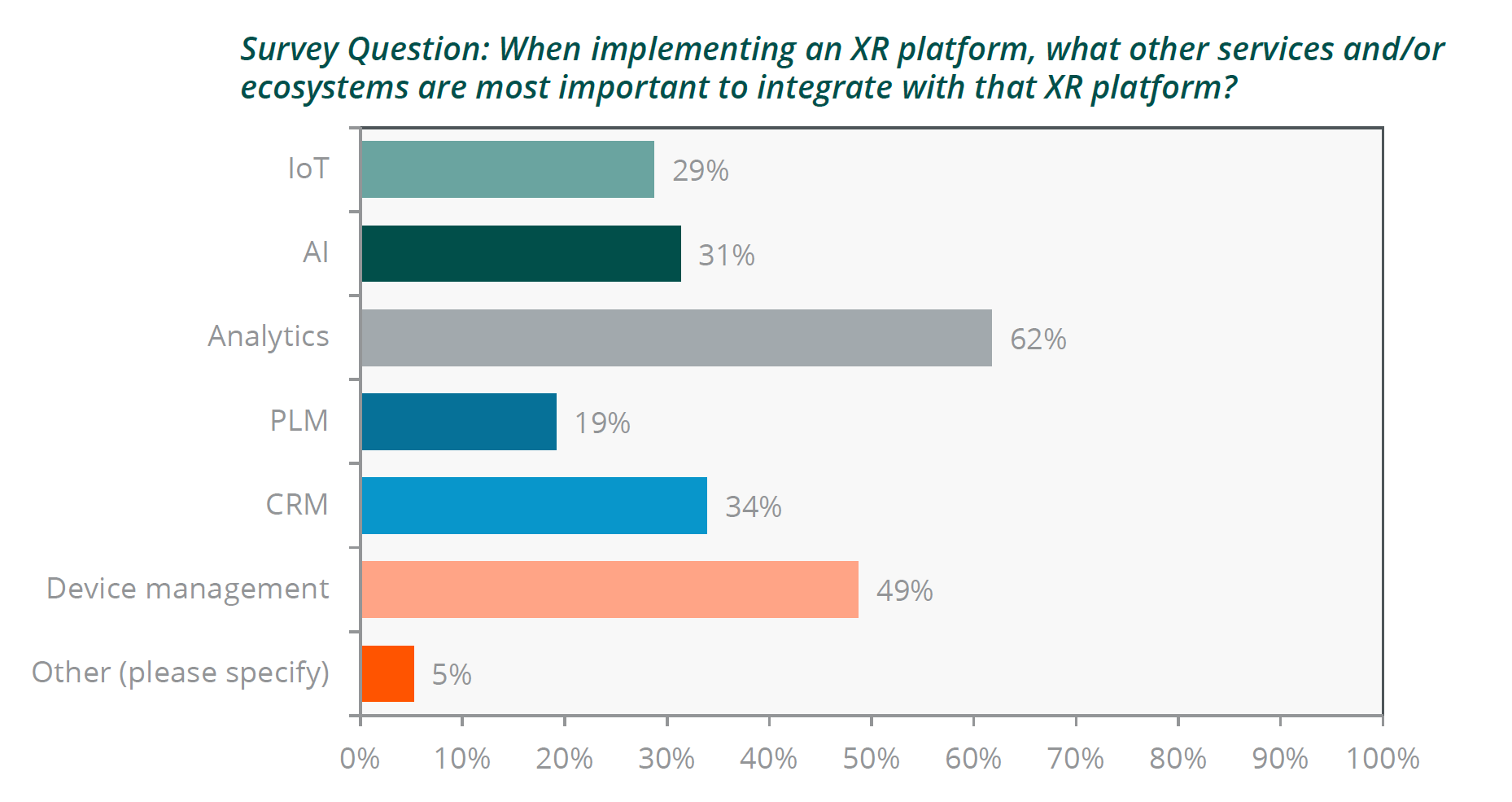Integrating Augmented Reality (AR) into the enterprise opens the door for new, innovative ways for the workforce to carry out their tasks. As pointed out in the blog post Use Cases of the Enterprise Metaverse and Immersive Collaboration (with Examples), AR is a key enabler for delivering immersive collaboration in the metaverse. Employee training was the leading enterprise AR use case in 2022, with additional value seen in areas such as remote assistance, workflow guidance, knowledge capture, and content creation.
As Industry 4.0 is further pushed and organizations try to improve operational efficiency, it’s only natural for the number of AR use cases to expand. However, implementing AR with existing infrastructure is not so easily accomplished. With this greater complexity, AR-focused vendors are shifting their business models and working to support a wide range of customer types with various integration needs.
Augmented Reality Integration Requirements Have Grown
As the AR market has matured and widened its scope, enterprises expect a greater variety of integrations that are built around existing systems and processes. Enterprises that have already adopted AR, notably in the industrial space, are introducing 3D interactivity to new use cases. That means customers need AR support for multiple device types (mobile devices, assisted reality, mixed reality) across varying segments.
Integrating Relevant Augmented Reality Platforms
While an Over-the-Top (OTT) AR solution can be viable for some enterprise use cases, it’s inherently more limited. On the contrary, considerations for integration need to be focused on myriad platforms, such as the following:
- Internet of Things (IoT): Enables processes (machines) and people to conjoin and can serve as a central axis for a digitized system. IoT platforms are also crucial for digital twins and transmitting real-time data to and from workers equipped with AR devices/smart glasses.
- Mobile Device Management (MDM): With the introduction of AR comes a new device type that has its own specific management needs for content, location of use, and shareability. If the hardware is compatible, MDM integration should be a straightforward process.
- Cloud: In addition to the aforementioned flexibility, the enterprise cloud also consolidates content and systems orchestration. A cloud system is also an important enabler of multi-user and multi-use case applications.
- Product Lifecycle Management (PLM) and Enterprise Resource Planning (ERP): PLM and ERP bridge the gap between a product and a potential AR user—imperative for a single source of truth. PLM and ERP platforms can also link with other platform types (e.g., PLM feeds an Artificial Intelligence (AI)-enabled data lake to an analytics platform).
- Customer Relationship Management (CRM): AR-CRM integration is mainly focused on orders and support. Furthermore, this unification allows a CRM solution to automate the uploading of rich AR-captured customer/user data.
- Content Capture and Creation: Streamlines the distribution of existing and new content types stemming from Computer-Aided Design (CAD), Three-Dimensional (3D) modeling, object-based creation, and workflow creation.
On a broader note, analytics is the most important service or ecosystem that enterprises care about being able to integrate Extended Reality (XR) with (see the Digital Maturity and Mixed Reality: Trends and Takeaways whitepaper for more on this).

Artificial Intelligence and Edge Computing for Enterprise Augmented Reality
Automation and prediction will be two prevailing next-generation AR use cases for enterprises. To make that possible, AR needs to be infused with AI for data capture and analytics. These tailored content deliveries also necessitate integration with suitable platforms, such as the Internet of Things (IoT)/PLM for data, MDM for user and content management, and content creation for anticipated needs.
As demand for offloading local data processing grows, so will demand for edge computing capabilities. Edge computing can improve battery life and enhance the user experience as long as the appropriate connectivity is in place. Integrating the edge is of utmost importance for AR applications that require accurate, instantaneous processing from multiple sensors. For example, in a warehouse setting, AR smart glasses need to be capable of capturing real-time data about various pallets, scan codes, and audio—all while giving the user access to their Warehouse Management System (WMS) software.
Can Augmented Reality Integration Be Simplified?
So far, AR integration has been seen as a Return on Investment (ROI) barrier to enterprises. Successfully implementing AR into a company’s existing technology stack necessitates the interaction between Information Technology (IT) and Operational Technology (OT)—no small feat. Moreover, many enterprise applications are highly complex and prone to errors when modifying them. For organizations adopting enterprise AR, it’s imperative to think about AR early on as it relates to their digital platforms. Which AR device needs are required? What platforms will interplay with AR? How is AR going to be used? Answering these questions early on before deployment will help speed up the integration process and prevent unexpected hiccups down the line.
To accommodate the growing needs of enterprises, Virtual Reality (VR) platform partners are stressing the importance of streamlined and flexible integration with existing and potential future infrastructure. Therefore, an à la carte, cloud-based Software-as-a-Service (SaaS) business model is playing a key role. Further, hardware bundling can potentially remove some of the convolutions from the AR integration process for enterprise customers.
To improve the time-to-value for customers, platforms and systems integrators should enable automated content creation and low-code/no-code AR solutions, while considering template-based builder tools. While the enterprise AR market has not yet fully embraced cloud-native solutions, and some customers will still desire tailored on-premises solutions, it is well on track to replace the dominance of hybrid deployments. This shift makes it clear that AR platforms and integrators need to have full cloud solutions in place to accommodate customer demand.
To learn more, download ABI Research’s presentation Maximizing Augmented Reality Value through Integration: Requirements, Best Practices, and Adapting Business Models. This research is part of the company’s Augmented & Virtual Reality Research Service.





